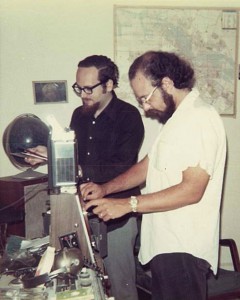Biography and Comments on the Music
by Walter Simmons
Click here for a short biography suitable for printing in concert programs.
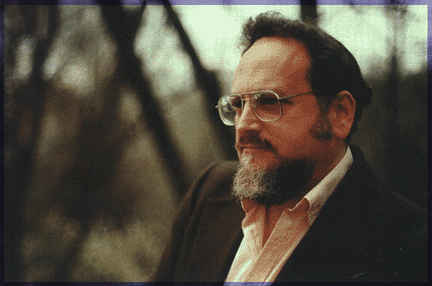
Biography
Arnold Rosner was one of the most unusual and fascinating American composers of his generation. Born in New York City in 1945, he took piano lessons as a boy—as did so many Jewish boys his age—although he did not especially enjoy the routine of practicing. But he did get hooked on classical music. Certain sounds in particular appealed to him—especially juxtapositions of major and minor triads—and before long he was working these sounds into music of his own. His family—fully aware of the remote prospects of success offered by a career in classical music composition—encouraged him to pursue more practical endeavors. So he attended the Bronx High School of Science, whence he graduated at the age of 15, and then New York University with a major in mathematics. But all the while he was composing—sonatas, symphonies, concertos, etc.—not that anyone else was especially interested in hearing the fruits of his labors. His composer-heroes at the time were Alan Hovhaness, Ralph Vaughan Williams, and Carl Nielsen, and their influence on his early creative work is readily apparent.
Graduating from NYU before he turned 20, Rosner then spent a year at the Belfer Graduate School of Science, continuing his studies in mathematics. But, no longer able to resist the inner drive to pursue musical composition as his primary activity, he entered the University of Buffalo the following September, with a major in music composition. This was 1966, when the serial approach dominated university music departments, and young composers were often coerced into adopting it, either directly or indirectly. Rosner was adamantly opposed to serialism and refused to embrace it. At Buffalo he was subjected to the tutelage of Leo Smit, Lejaren Hiller, Henri Pousseur, and Allen Sapp, who dismissed his creative efforts with varying degrees of contempt. In describing his educational experience at Buffalo, Rosner later wrote that he “learned almost nothing” from these pedants. While his fellow composition students may have capitulated to the pressure to embrace the style du jour, Rosner stubbornly refused to accept a view of music that violated his most fervently held artistic values. And so, in response, his department rejected the work he had submitted as his dissertation: a large composition for orchestra entitled Perchance to Dream, which has yet to be performed. Realizing that they would never accept the kind of work he considered legitimately meaningful, he gave up the notion of a doctorate in composition, and decided instead to pursue a degree in music theory, with a dissertation—the first ever—on the music of Alan Hovhaness. He completed this successfully, and in the process became the first recipient of a doctorate in music granted by the State University of New York.
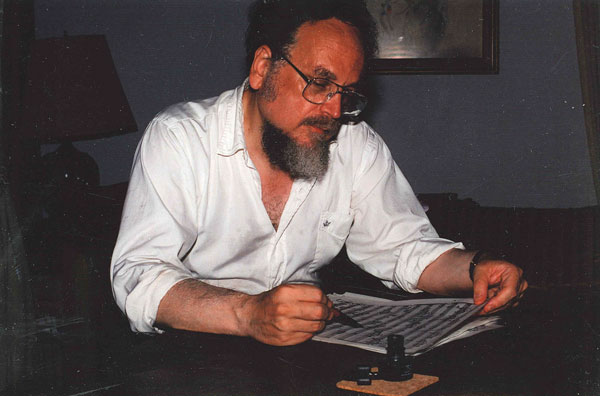
Rosner devoted the rest of his life to writing the music that represented his personal aesthetic ideals, supporting himself through academic positions at colleges in and around the New York City area. His most enduring position was as Professor of Music at Kingsborough  Community College (of the City University of New York), which he held for thirty years, until his death in 2013.
Community College (of the City University of New York), which he held for thirty years, until his death in 2013.
Although his music attracted little attention and enjoyed very few performances, Rosner persisted nonetheless. Fiercely independent, he shunned any of the institutions or organizations with which he might have aligned himself. Despite spending most of his career in academic settings, he never took advantage of the opportunities open to academic composers. As desperately as he sought acceptance, he would have it only on his own terms. He did little to cultivate performances of his music, so initially his work attracted the attention of only a small number of equally independent-minded musicians and music lovers. As the years passed, his works gained no foothold within the world of professional musicians, and he became increasingly embittered.
As he wrote to a friend in 2009:
My music is plenty obscure now, but when I was writing the [works of the 1960s and 70s] I was so nowhere that I am astonished now that I had the impetus and nerve to keep up doing it. Indeed, as we speak, I am listening to [the recording of my Symphony No. 5], which I wrote with NO prospect of ever hearing it. I do it because I have to do it—that is why I am on this planet.
Deciding simply to bypass the conventional music institutions, he began to produce recordings of his music and make them available to the public. These recordings, where a sizable portion of his output may be heard, have been highly praised by most of the review media, and Rosner has begun to develop a following of committed enthusiasts who recognize the value of his unique voice.
In addition to music, Rosner’s other passions included exotic cooking and playing contract bridge, in which he was a tournament champion.
About the Music
Arnold Rosner was one of the true maverick composers of his generation. In some ways it is easier to define his approach to music by noting what he shunned rather than by what he embraced. Rosner rejected all the compositional styles that seized the limelight during the course of his career. Though in many ways a staunch traditionalist, he didn’t align himself with more conservative approaches either. While he decried what he saw as the sterility of the serialists and the experimentalists, as well as the mindlessness of the minimalists, he also loathed the sentimentality of the neo-romantics and the dry formalism of the neo-classicists. He developed his musical ideals around the time that he entered high school, refining and elaborating this vision throughout the remainder of his life. He paid a significant price for his stubborn refusal to adopt the musical values of his time.
Rosner’s op. 1, a short piano piece, was dated 1956, when he was 11. He was fascinated by modal scales, as well as by the juxtaposition of major and minor scales and triads. These devices formed the initial basis of his musical style, although some years later he suppressed much of his early music (up through op. 30 [1965]). But he retained them in his list of works, and released some for performance after revising them. Excellent examples of this period are the String Quartet No. 2, op. 19 (1963, rev. 1993) and the Piano Sonata No. 1, op. 25 (1963).
As he wrote in 1989:
My earliest compositions were most strongly influenced by the Romantics. In my ‘teens I had already written four symphonies clearly in the Dvorak–Mahler–Shostakovich lineage. By 1967, two distinct forces brought about at least a temporary change. The first was the simple fact that virtually none of my works had been performed and that my full orchestral scores seemed relegated to permanent obscurity. The second was the study, at the graduate level, of Renaissance music in general and the works of Josquin des Prez in particular.
With remarkable ease Rosner managed to integrate the modal polyphony of the Renaissance and early Baroque, and later the pre-tonal harmony of late Medieval dance music, into the language he had begun to develop—a language that was already quite compatible with such infusions. He embraced the free triadicism and rhythmic  phraseology of that music, and the result became the substructure on which most of his subsequent work was predicated, regardless of how far from those sources he ventured. He saw a world of difference between the free triadicism of Monteverdi and Gesualdo, and the major-minor dualism of Classical 18th-century tonality, which he despised and found insipid. He enriched these rather austere elements with a pinch of Judaica and other ethnic seasonings, and combined them with the rich luxuriance of 19th-century orchestration and a Romantic sense of drama. In some works he displayed a Hindemithian vigor and in others the stark brutality of Shostakovich. These basic elements may seem to some antithetical to each other, but therein lies the remarkable individuality of Rosner’s music. When he discovered pieces such as the Fantasia on a Theme of Thomas Tallis by Vaughan Williams, Mysterious Mountain by Alan Hovhaness, the symphonies of Carl Nielsen, and the Eleventh Symphony of Shostakovich, he regarded them as precedents that justified the ideal vision he sought to realize.
phraseology of that music, and the result became the substructure on which most of his subsequent work was predicated, regardless of how far from those sources he ventured. He saw a world of difference between the free triadicism of Monteverdi and Gesualdo, and the major-minor dualism of Classical 18th-century tonality, which he despised and found insipid. He enriched these rather austere elements with a pinch of Judaica and other ethnic seasonings, and combined them with the rich luxuriance of 19th-century orchestration and a Romantic sense of drama. In some works he displayed a Hindemithian vigor and in others the stark brutality of Shostakovich. These basic elements may seem to some antithetical to each other, but therein lies the remarkable individuality of Rosner’s music. When he discovered pieces such as the Fantasia on a Theme of Thomas Tallis by Vaughan Williams, Mysterious Mountain by Alan Hovhaness, the symphonies of Carl Nielsen, and the Eleventh Symphony of Shostakovich, he regarded them as precedents that justified the ideal vision he sought to realize.
But what makes Rosner’s music worthy of serious consideration, rather than being merely a homogenization of earlier styles, is the way that his unusual language is capable of embracing an enormous expressive range—far broader than one might imagine possible—from serene beauty to violent rage, with many points in between. And despite its fusion of seemingly incongruous elements, most of his music is readily accessible to even untutored listeners. Among the finest examples of Rosner’s work from the 1970s and early 80s are: String Quartet No. 4, op. 56, Symphony No. 5, op. 57, Requiem, Op. 59, Musique de Clavecin, op. 61, Sonata for Horn and Piano, op. 71, Magnificat, op. 72, and—one of his most ambitious compositions—the full-length opera, The Chronicle of Nine, op. 81, from which he extracted his Symphony No. 7, “The Tragedy of Queen Jane.”
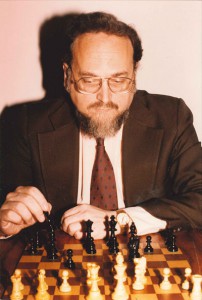
In 1983 another feature was integrated with remarkable fluidity into Rosner’s style. Revealing a surprising affinity with some minimalist practices, this technique, which he called “stile estatico,” first appeared in a work for two pianos called Of Numbers and of Bells, op. 79. In an interview published during the last year of his life, he discussed such pieces in which he used “a complex cross-rhythm or cross-color overlap.”
I sometimes have sections and even whole movements that feature cross-rhythms and irregular combinations of harmony or scoring. Imagine high-register strings moving once per second, trombones once every two seconds, and harp and chimes once every five seconds. Of course, they are often “out of phase” with each other. I try for a colorful texture with high spiritual intent.
In addition to Of Numbers and of Bells, among the works that feature stile estatico are Symphony No. 8, “Trinity,” op. 84, Gematria, op. 93, Piano Quintet No. 2, op. 103, and Three Northern Sketches, op. 117.
Arnold Rosner’s final output comprises three operas, eight symphonies, six string quartets, three a cappella Mass settings and the large Requiem, three piano sonatas, and a host of other orchestral, choral, and chamber works.
Walter Simmons has received the National Educational Film Festival Award and the ASCAP/Deems Taylor Award for music criticism. He has contributed articles to The New Grove Dictionary of American Music, American National Biography, Fanfare, Music Journal, and Musical America. Simmons has published two acclaimed books: Voices in the Wilderness: Six American Neo-Romantic Composers and Voices of Stone and Steel: The Music of William Schuman, Vincent Persichetti, and Peter Mennin. Simmons knew Arnold Rosner from 1970 until the latter’s death, and has been a consistent advocate for his work.
(Pictured at right: Arnold Rosner and Walter Simmons, working at reel-to-reel tape machines, June 1974)
Short Biography
(suitable for printing in concert programs)
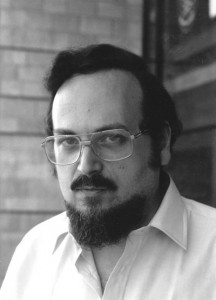 Arnold Rosner was one of the true mavericks among the American composers of his generation. Born in New York City in 1945, he lived and worked there for most of his life, which ended on his 68th birthday in 2013. Rosner rejected all the compositional trends that appeared on the scene during the years he was active. He had developed his own musical language during his teens—a language based on simple modal scales, but he later came to embrace elements of Medieval and Rennaissance music, aspects of non-Western music, and even an idiosyncratic adaptation of minimalism, all of which he integrated into his own unique style. He continued to develop and refine his approach throughout his life, creating a medium for expressing a wide range of personal feelings and emotions, from spiritual ecstasy to violent rage. Despite these relatively exotic influences, he described his aesthetic as basically “neo-romantic.” During a period when audiences have often found new music hard to grasp and appreciate, Rosner’s work is readily accessible to casual listeners, yet remains fascinating to connoisseurs as well. His output comprises more than 120 works, including three operas, eight symphonies, six string quartets, and numerous choral, vocal, instrumental, and keyboard compositions. Representative pieces for all these media are available on recordings. www.arnoldrosnermusic.com (Walter Simmons)
Arnold Rosner was one of the true mavericks among the American composers of his generation. Born in New York City in 1945, he lived and worked there for most of his life, which ended on his 68th birthday in 2013. Rosner rejected all the compositional trends that appeared on the scene during the years he was active. He had developed his own musical language during his teens—a language based on simple modal scales, but he later came to embrace elements of Medieval and Rennaissance music, aspects of non-Western music, and even an idiosyncratic adaptation of minimalism, all of which he integrated into his own unique style. He continued to develop and refine his approach throughout his life, creating a medium for expressing a wide range of personal feelings and emotions, from spiritual ecstasy to violent rage. Despite these relatively exotic influences, he described his aesthetic as basically “neo-romantic.” During a period when audiences have often found new music hard to grasp and appreciate, Rosner’s work is readily accessible to casual listeners, yet remains fascinating to connoisseurs as well. His output comprises more than 120 works, including three operas, eight symphonies, six string quartets, and numerous choral, vocal, instrumental, and keyboard compositions. Representative pieces for all these media are available on recordings. www.arnoldrosnermusic.com (Walter Simmons)
